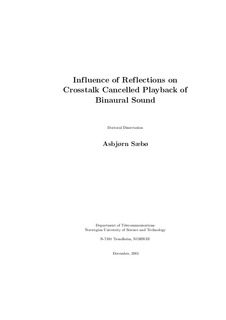| dc.description.abstract | This work has investigated how crosstalk cancelled loudspeaker reproduction of binaural sound intended for anechoic conditions is influenced by taking place under non-anechoic conditions. The scope has been limited to an investigation of the effect of early reflections on localisation for target directions in the horizontal plane.
Crosstalk cancellation was implemented in software, with routines for the inversion of transfer functions, the design of crosstalk cancelling filters, filtering of sound and playback simulation. The system for crosstalk cancellation was found to give a realistic, natural and convincing reproduction of binaural signals.
The effect of a single reflecting surface on a given setup for crosstalk cancelled loudspeaker playback was studied using a simplified model and playback simulation. It was found that the crosstalk cancelling filtering designed for the direct sound would not give crosstalk cancellation for the reflected sound, that the reflections in many cases were not geometrically plausible for a real source in the intended source directions, and that the interaural time difference for the reflections was nearly equal to that for a source placed at the reflecting surface.
The effect of reflections delayed 5 ms and 10 ms with respect to the direct sound was investigated through listening tests. The playback setup was two Bowers & Wilkins 801 loudspeakers placed next to each other in front of the listener, at two meters distance, in an anechoic room. The reflections came from front left and front right, and were produced using reflecting surfaces. Five setups were used: Anechoic, close wall, close wall with reflection cancelling, far wall and two walls. Crosstalk cancelled binaural recordings of male and female speech from sixteen directions were used as source signals. A total of 5180 answers were collected from nine participants
The listening test data were bimodally distributed due to front/back reversals. A model for statistical characterisation of such data was developed. The model describes reversed and unreversed answers independently, and may be used to find estimates for reversal rate, average perceived directions and spread for reversed and unreversed answers. The model was used to describe the listening test data.
The deviation of the perceived directions from the presented directions was studied, and used to compare the setups with reflections to the anechoic setup. The results showed that compared to anechoic reproduction, localisation was altered for reproduction taking place under non-anechoic conditions. It was found that the deviation of the average perceived directions from the presented directions was higher for the setups with reflections than for the anechoic setup. The setups with reflections also had relatively more answers localised towards the direction of the reflection(s). The non-anechoic setups showed reversal patterns differing from those for the anechoic setup, reversal rates 11 to 30 percent higher than for the anechoic setup, and a larger fraction of answers localised to the front half plane. Generally it was found that the setups that differed most from the anechoic setup (close wall, two walls) also gave the localisation that differed most from localisation in the anechoic setup. Reflection cancelling was found to give results closer to the anechoic setup than the identical setup without reflection cancelling did. | nb_NO |
